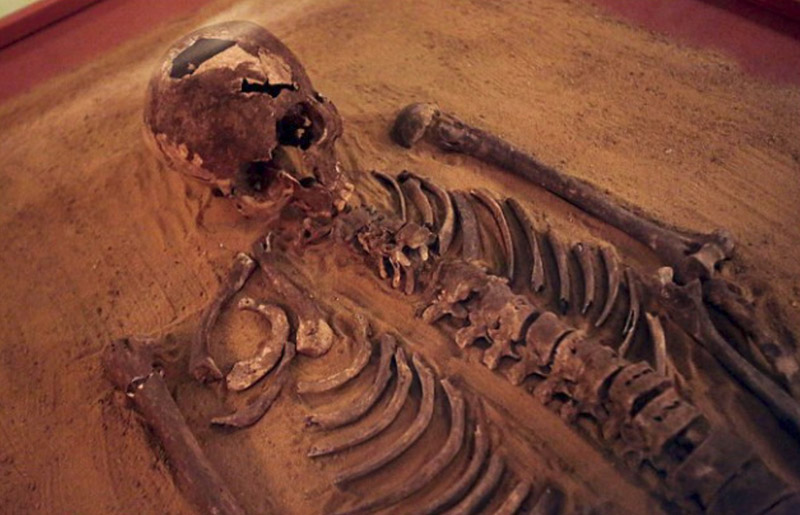Traditional historical accounts which claim the Phoenicians were all Semitic has been turned on its head with the news that ancient DNA extracted from a 2,500-year-old Phoenician skeleton has unquestionably shown European racial origins.
The study found that the DNA of the famous “’Young Man of Byrsa,” was an extremely rare—and exclusively European marker—and that this is likely the result of extensive admixture with Europeans.

The ‘Young Man of Byrsa” skeleton.
The study, published in the PLOS ONE journal, was conducted by a research team under the leadership of Elizabeth A. Matisoo-Smith, Professor of Anatomy, from New Zealand’s University of Otago, and is titled “A European Mitochondrial Haplotype Identified in Ancient Phoenician Remains from Carthage, North Africa.”
Professor Matisoo-Smith’s team recovered DNA from the skeleton found in a tomb in Carthage, Tunisia in 1994. It is the very first ancient DNA to be obtained from Phoenician remains.
Professor Matisoo-Smith said the findings provide the earliest evidence of the European mitochondrial haplogroup U5b2c1 in North Africa and date its arrival to at least the late sixth century BC.
“U5b2c1 is considered to be one of the most ancient haplogroups in Europe and is associated with hunter-gatherer populations there. It is remarkably rare in modern populations today, found in Europe at levels of less than 1 percent,” she said.
While the Phoenicians are thought to have originated from the area that is now Lebanon, their influence expanded across the Mediterranean and west to the Iberian Peninsula where they established settlements and trading posts.
The city of Carthage in Tunisia, North Africa, was established as a Phoenician port by colonists from Lebanon and became the center for later Phoenician (Punic) trade.
Later, Carthage became Rome’s greatest early enemy, and a series of wars, known as the Punic Wars, erupted, ending in Carthage’s total destruction, resulting in the effective disappearance of the Phoenician culture.
Previous research has found that U5b2c1 was present in two ancient hunter-gatherers recovered from an archaeological site in northwestern Spain, Professor Matisoo-Smith said.
“This result not only provides the first direct ancient DNA evidence of a Phoenician individual but the earliest evidence of a European mitochondrial haplogroup, U5b2c1, in North Africa,” the research paper continues.
The paper said that items buried with the skeleton dated from the late sixth century BC. The first indication that he was not Semitic came with a cranial analysis, the paper said: “An osteological analysis of the young man from Byrsa, or Ariche, as he has become known, determined that he was approximately 1.7 m tall and aged between 19 and 24 years, and a craniometric analysis indicated likely Mediterranean/European ancestry as opposed to African or Asian.”
With reference to the DNA results—extracted from a rib bone the team was allowed to study—the paper said that “Haplogroup U5 is considered to be one of the most ancient haplogroups in Europe and is believed to have arisen there.
“It is not uncommon in Mesolithic European populations, particularly those from Central and Eastern Europe.
“Haplogroup U5b2c1 has been identified in both La Braña 1 and 2, the 7000-year-old remains recovered from the La Braña-Arintero site in León in Northwestern Spain. All of the reported U5b2c1 carriers are of presumably (if not specifically stated) European ancestry, from Spain, Portugal, England, Ireland, Scotland, the United States, and Germany.”
“While the U5b2c2 sequences all originate in Central and Northwestern European or likely derived populations (e.g. US Caucasian), and the U5b2c sequences in GenBank originate in Germany and England respectively (both samples from Family Tree DNA), it is likely that U5b2c originated in Central/Northwestern Europe,” the paper said, adding that additional DNA results indicated a close relationship to one living person in Portugal.
The paper then points out that it is “unlikely” that the subject of the study was directly descended from colonizers from Lebanon, “as the haplogroup U5b2c has not been identified in our modern Lebanese samples or in ancient (early Neolithic, PPNB) remains from the Levant.”
The man’s origin is therefore from Europe, the paper goes on: “Given that haplogroup U5b2c1 has not been previously reported in North Africa, we suggest that the ancestry of our young man is likely traced to some population across the Mediterranean, which is consistent with his proposed European cranial traits.”
The paper then poses the question: “So how did a young Phoenician man, with a European mitochondrial lineage, end up in Carthage, North Africa?”
The answer to this, the paper continues, is that there was a population transference from Europe to Carthage at some earlier point in history.
“The earliest Phoenician site in Iberia is believed to be Gadir or Cadiz as it is known today, established in 1110 BC. Phoenician colonies were also established in Ibiza, southern Sardinia, western Sicily, and along the southern shores of the Iberian Peninsula and, later, these were also major Carthaginian trade ports.
“It has been suggested that the Phoenician east-west trade route from Tyre and Sidon across the Mediterranean and through the Straits of Gibraltar departed following a northerly route, travelling with the prevailing winds and tides westward, stopping in Cyprus, Sicily, Ibiza, and several locations along the southern coast of Spain, reaching Cadiz and beyond.”
The highest modern frequency of the haplogroup today is in the Iberian Peninsula and U5b2c1 was also present there in Mesolithic hunter gatherers, it continues, saying that the most likely explanation is that “individuals carrying these ancient European lineages were transported to Carthage via the Phoenician/Punic trade networks.”
In other words, by the time of the Roman-Punic Wars, the racial makeup of the Phoenician people was clearly different to that which it had been in the preceding centuries. This conclusion is highly significant for a greater understanding of ancient history, and the conflict between Rome and Carthage in particular.